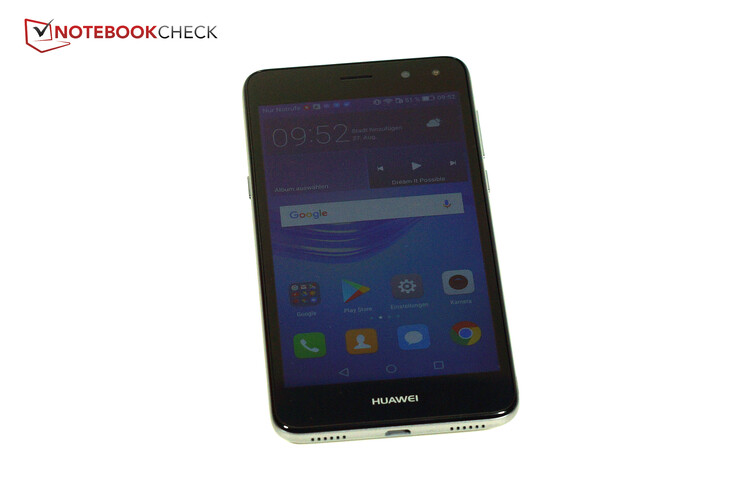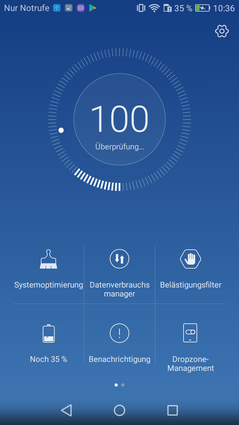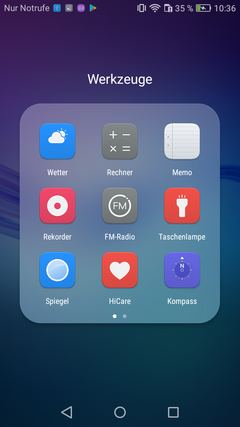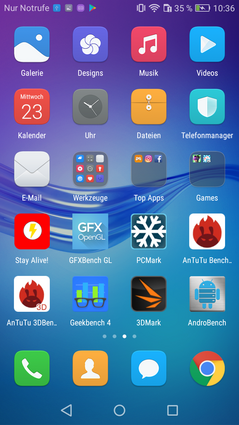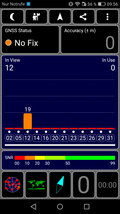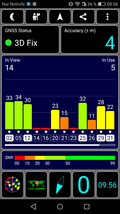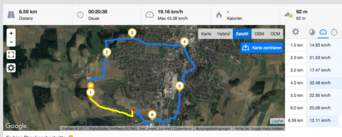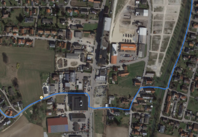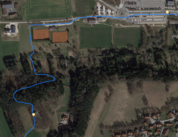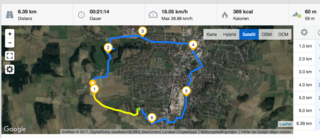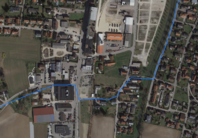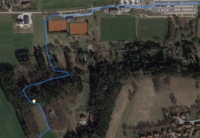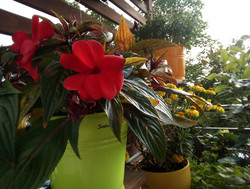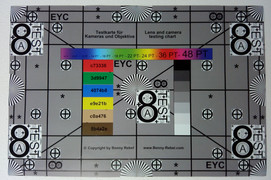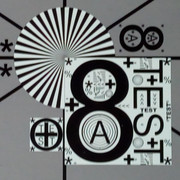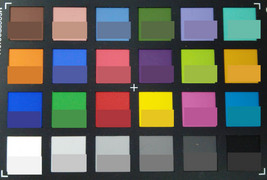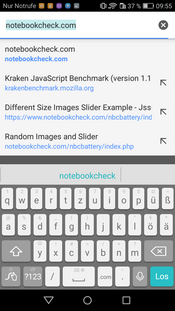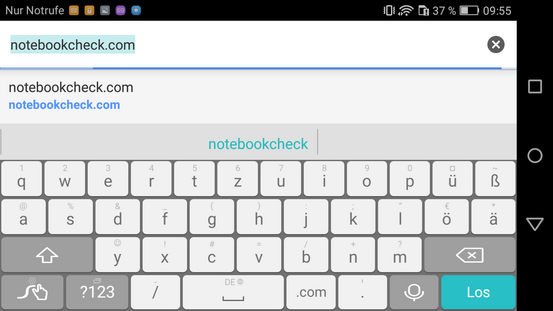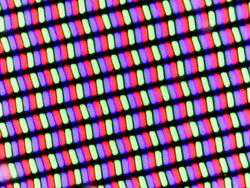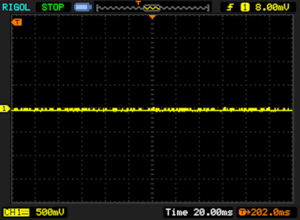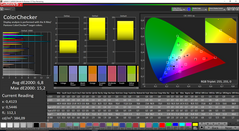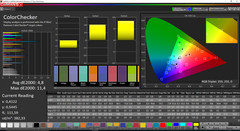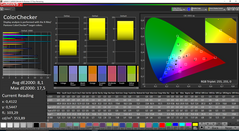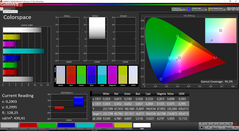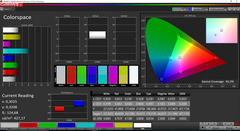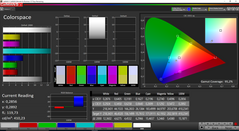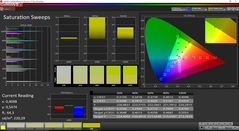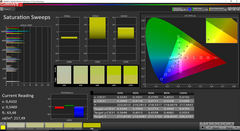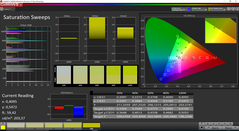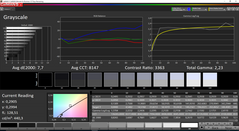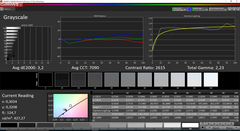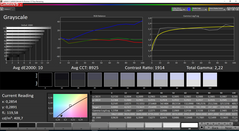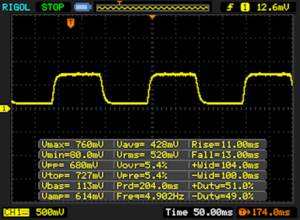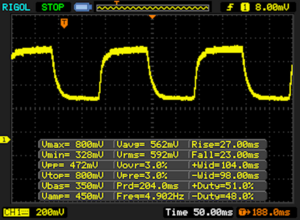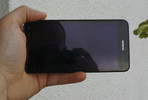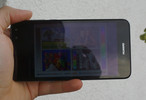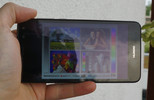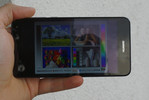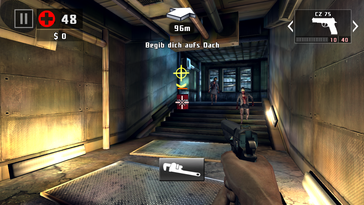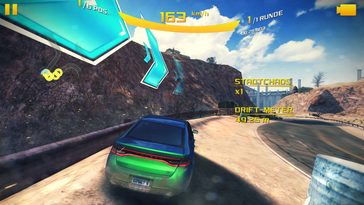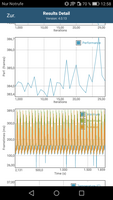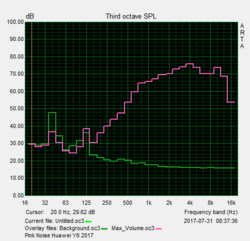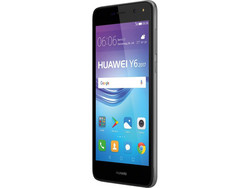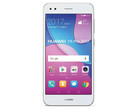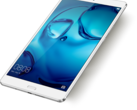Huawei Y6 2017 Smartphone Review
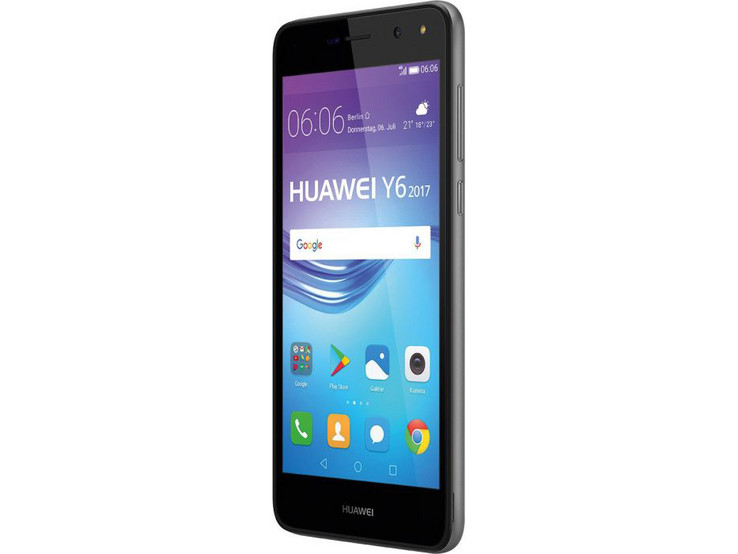
For the original German review, see here.
The Huawei Y6 (2017) is a 5-inch smartphone, which belongs to the upper price range of entry-level devices with an RRP of just under 160 Euros (~$135). The Chinese manufacturer wants to attract prospective buyers with a large battery for this category, decent performance and a freely configurable button. This sounds like a good offer, but the Nokia 3, Gigaset GS170, Sony Xperia E5 or Samsung Galaxy J3 are similarly priced. Can the Huawei Y6 (2017) bear up against these good smartphones?
Case
The Huawei Y6 (2017) is available in three color options: white, gray, or gold. The gray model features a black front side; the others match colors front and back. The case is quite stable; it hardly twists or creaks. Only high pressure causes ripples on the liquid crystal display.
The size is on par with similarly expensive smartphones with the same display size. The case is several tenths of a millimeter higher than other devices', which might be caused by the high-capacity battery. The Y6 also weighs a few grams more. But, both differences are that small that they are acceptable in favor of a longer battery life. Thanks to curved edges, the smartphone sits comfortably in the hand.
The removable rear cover allows replacing SIM cards and microSD card, but the battery cannot be removed (that easily).
Connectivity
2 GB RAM and 16 GB of storage appear to be standard in this price category. The RAM capacity is sufficient for everyday tasks, but you should not work with too many apps, which are left open in the background. 10.6 GB of the storage space are free for your data and apps in delivery state. That is okay, but those who like to run games or install other large apps will run out of storage soon. In return, you can add up to 128 GB storage with a microSD card. There is a dedicated microSD slot. Hence, you do not have to give up one of the dual SIM slots. Apps can be installed on the memory card if the app allows you to do so.
Software
The Huawei Y6 (2017) is based on Android 6.0. At the time of the test, the security patches were already outdated and an update was not available. It is not to be expected that an update will be rolled out since not much effort is put into cheap devices. Huawei's EMUI over Android changes the appearance and adds features, but those familiar with Android will quickly get along with it.
You have to accept several advertising apps and preinstalled Free2Play games, but there are not too many. In addition, Huawei installs many more or less useful tools, which you can uninstall if you do not like them. One of them simulates a mirror by means of the front camera and another one a torch. Many UI designs are available, but only one is preinstalled at the beginning. The phone manager helps to keep memory consumption low and keep an eye on power consumption. The settings are slightly pooled and advanced settings are hidden in a sub function. The notification center has also been slightly redesigned.
Communication and GPS
Wi-Fi standards 802.11 b/g/n are usual in this price class and the Huawei Y6 (2017) provides it. Hence, it cannot access the less used 5 GHz band, but ensures fairly fast internet connections. Nevertheless, it does not exploit modern DSL rates: In our standardized Wi-Fi test, the smartphone remains under 50 MBit/s in sending and receiving and is the slowest model in our comparison group. In our real-world test, we check opening times of various web sites close to the router. While full reception is available in this scenario, loading images still takes a long time. We still had the full signal and high transmission rates at a distance of ten meters (~33 ft) to the router and through three walls in the home wireless network. Loading took similarly long as close to the router.
Huawei is a bit stingy in cellular networks with only five LTE bands. It covers all networks important for middle Europe however. Other smartphones offer more LTE bands, for example, the Nokia 3 has as much as nine LTE bands available. LTE Cat. 4 is the standard in this class, which is met by the Huawei Y6. The reception is decent: In the well-developed German D2 network, we had at least half the reception in the city, even in buildings.
| Networking | |
| iperf3 transmit AX12 | |
| Sony Xperia E5 | |
| Nokia 3 | |
| Samsung Galaxy J3 2017 | |
| Gigaset GS170 | |
| Huawei Y6 2017 | |
| iperf3 receive AX12 | |
| Nokia 3 | |
| Sony Xperia E5 | |
| Gigaset GS170 | |
| Samsung Galaxy J3 2017 | |
| Huawei Y6 2017 | |
The GPS module of the Huawei Y6 (2017) is not able to geolocate indoors. Outdoors, geolocation takes some time, the accuracy increases slowly and finally reaches a good value of 4 meters (~13 ft).
For more real-world relevance of our tests, we took the Huawei Y6 and the Garmin Edge 500, a professional navigation device, on a bike tour. The course is about 200 meters (~656 ft) shorter than what the reference navigation device reports when measured by the Y6. This difference is just acceptable for a course of about 6.5 km (~4 miles). The Y6 sometimes lost contact to the satellites for a long time and drew straight lines between remote measuring points. This can be seen in the Runtastic app, which we use to evaluate the data. Nevertheless, the Huawei Y6 is able to track the course sufficiently accurately most of the time. Hence, you can easily use the smartphone as a free time navigation device.
Telephone and Call Quality
Huawei changed the telephone app, but stuck to the basic concept of the Google's standard app: A number field and a call list are displayed first. You can directly access contacts and favorites via tabs on the top. Spam filter and call rejection via SMS are available, too. Overall, the app is well arranged and it is logical how to use it.
The call quality is decent: The conversation partner sounds clear, but not especially loud, while our own voices sounded loud to the conversation partner; even when we spoke softly. Those with loud voices might face problems since the microphone is quickly overdriven. Those who want to use hands-free equipment, have to get along with the squawking speaker, which distorts the voice of the conversation partner and generates disturbing noise. Our voice is transmitted with significant noise and sounds strangely distant.
Cameras
13 MP rear camera and 5 MP front camera: This is how typical mid-range phones are equipped nowadays. The Huawei Y6 (2017) also uses this combination. As small advantage compared to other models, the rear camera features a dual LED flash, which ensures the right flash color in different scenarios. The front camera also features an LED flash.
The 5 MP front camera shoots quite sharp images with decent colors in good distance. Moreover, the dynamic is decent in dark parts, while bright parts are slightly overexposed.
The main camera on the rear side shoots images with quite cool colors. Details and larger color fields appear pixelated at a closer look. Bright parts get quickly overexposed and the dynamic is not ideal in dark parts. Images could be sharper. The video quality is 1080p at 30 fps. Colors appear decent in videos, details are quite sharp. The exposure also adjusts quite quickly to the situation. However, you sometimes have to correct the autofocus, since it does not always select the correct sharpness. You can use several filters during recording of photos and videos. Moreover, the software includes a beautification mode, which lets skin blemishes disappear. The fast-motion mode records a video, which is simply played faster. You do not have any options here. The image suddenly blurred during our test and we could not correct the focus.
The camera is okay for occasional use. Those who expect more than snapshots from a smartphone camera can also find a suitable model in this price class: The Galaxy J3 creates significantly sharper recordings.
The main camera gets another chance: We shot images of our reference card under fixed lighting conditions in our lab. The images are very blurry. Hence, we cannot say much about the quality of details and text on colored background. We could detect inaccurate edges and stained color fields when we checked the colors. Colors are slightly too pale in general.
Accessories and Warranty
Apart from a charging adapter and a USB cable, Huawei also includes an in-ear headset, which is sufficient for occasional telephone calls or as replacement headphones. Currently, Huawei does not offer specific accessories in its shop.
The warranty for the device is 12 months, 6 months for the battery, and 3 months for the headphones. Please see our Guarantees, Return policies and Warranties FAQ for country-specific information.
Input Devices & Handling
The virtual keyboard from Huawei stems from the manufacturer Nuance and is called Swype. It is also available for all other smartphones in the Google Play Store. The keys are quite small in portrait mode. In return, there are small gaps between the letters. Nevertheless, we found it more difficult to hit the right keys than with Google's standard keyboard. It is easy to change the keyboard app or download a new app from the Play Store and install it.
There is a freely configurable button, the so-called Easy Key, on the left side of the Huawei Y6 (2017)'s case. Upon first press, the related app is opened, and you can assign actions or apps to short, long, or double press. This is easy and the number of options is exemplary.
The menu buttons of Android are only displayed on the screen. Thanks to the comfortable touchscreen surface, which is also very sensitive at the edges, they are easy to use.
Display
The 5-inch display offers the usual resolution for this price class with 1280x720 pixels. It is not particularly bright with an average of 432.1 cd/m² however. Several models in our comparison group including the Xperia E5 and Galaxy J3 have significantly brighter displays. The brightness distribution is quite even with 90%. As a result, even larger color fields look evenly lit.
| |||||||||||||||||||||||||
Brightness Distribution: 90 %
Center on Battery: 438 cd/m²
Contrast: 3369:1 (Black: 0.13 cd/m²)
ΔE Color 4.8 | 0.5-29.43 Ø5
ΔE Greyscale 3.2 | 0.57-98 Ø5.3
95.3% sRGB (Calman 2D)
Gamma: 2.23
| Huawei Y6 2017 IPS, 1280x720, 5.00 | Nokia 3 IPS, 1280x720, 5.00 | Gigaset GS170 IPS, 1280x720, 5.00 | Sony Xperia E5 IPS, 1280x720, 5.00 | Samsung Galaxy J3 2017 PLS, 1280x720, 5.00 | |
|---|---|---|---|---|---|
| Screen | -45% | -93% | -27% | -18% | |
| Brightness middle | 438 | 481 10% | 418 -5% | 538 23% | 502 15% |
| Brightness | 432 | 469 9% | 418 -3% | 534 24% | 494 14% |
| Brightness Distribution | 90 | 84 -7% | 92 2% | 96 7% | 89 -1% |
| Black Level * | 0.13 | 0.22 -69% | 0.45 -246% | 0.33 -154% | 0.35 -169% |
| Contrast | 3369 | 2186 -35% | 929 -72% | 1630 -52% | 1434 -57% |
| Colorchecker dE 2000 * | 4.8 | 8.1 -69% | 9.7 -102% | 5.7 -19% | 4.6 4% |
| Colorchecker dE 2000 max. * | 11.4 | 15.4 -35% | 18.9 -66% | 11 4% | 8 30% |
| Greyscale dE 2000 * | 3.2 | 8.5 -166% | 11.3 -253% | 4.7 -47% | 2.5 22% |
| Gamma | 2.23 99% | 2.16 102% | 2.27 97% | 2.51 88% | 2.29 96% |
| CCT | 7090 92% | 9014 72% | 10414 62% | 7264 89% | 6351 102% |
* ... smaller is better
Screen Flickering / PWM (Pulse-Width Modulation)
| Screen flickering / PWM not detected | |||
In comparison: 53 % of all tested devices do not use PWM to dim the display. If PWM was detected, an average of 17903 (minimum: 5 - maximum: 3846000) Hz was measured. | |||
Although the brightness of the display is relatively low, the Huawei Y6 (2017) achieves a great contrast of 3369:1. Hence, the black value has to be very good, since the contrast is calculated from black value and brightness. 0.13 cd/m2 actually is a very good value for the brightness of black fields. Colors still do not appear vibrant.
The color temperature can be adjusted continuously, but you can also select one of three presets: standard, cold, and warm. We checked the color representation of all three settings with the CalMAN software and the spectrophotometer. The color shift compared to the reference color space is big; especially for blue colors. The average color shift of all colors is acceptable however. The mode "warm" delivers the best results. Hence, it can be suspected that the image is quite bluish with standard settings. This is actually very evident in the gray scales in standard and cold mode.
Display Response Times
| ↔ Response Time Black to White | ||
|---|---|---|
| 24 ms ... rise ↗ and fall ↘ combined | ↗ 11 ms rise | |
| ↘ 13 ms fall | ||
| The screen shows good response rates in our tests, but may be too slow for competitive gamers. In comparison, all tested devices range from 0.1 (minimum) to 240 (maximum) ms. » 48 % of all devices are better. This means that the measured response time is worse than the average of all tested devices (21.5 ms). | ||
| ↔ Response Time 50% Grey to 80% Grey | ||
| 50 ms ... rise ↗ and fall ↘ combined | ↗ 27 ms rise | |
| ↘ 23 ms fall | ||
| The screen shows slow response rates in our tests and will be unsatisfactory for gamers. In comparison, all tested devices range from 0.2 (minimum) to 636 (maximum) ms. » 84 % of all devices are better. This means that the measured response time is worse than the average of all tested devices (33.7 ms). | ||
The Huawei Y6 (2017) can be used outdoors and even the built-in brightness sensor works reliably there. However, the glossy display becomes a problem under direct sunlight. Hence, the smartphone is more suitable for use in the shade.
The viewing angles are good. A small brightness loss is notable when inclining to top or bottom. However, it is relatively low.
Performance
Huawei usually uses SoCs from its own manufacturer HiSilicon in its smartphones. However, the Chinese follow a different strategy here: A Mediatek MT6737T is used. It features four cores and clocks at up to 1.5 GHz. With it, the Huawei Y6 delivers slightly higher performance than usual in this class and can take the lead in almost all benchmarks. Depending on the competitor, the Huawei is up to 30% faster. You can notice this in everyday use since navigation through the operating system does not stutter and demanding apps run smoothly.
Our test model uses the same graphic solution as many models in the comparison group: The dual-core ARM Mali-T720 MP2 with a clock rate of up to 650 MHz. The higher CPU performance also has an impact on the graphic benchmarks. The Huawei Y6 (2017) always comes out top here, too.
| AnTuTu v6 - Total Score (sort by value) | |
| Huawei Y6 2017 | |
| Nokia 3 | |
| Gigaset GS170 | |
| Sony Xperia E5 | |
| Samsung Galaxy J3 2017 | |
| PCMark for Android | |
| Work performance score (sort by value) | |
| Huawei Y6 2017 | |
| Nokia 3 | |
| Gigaset GS170 | |
| Sony Xperia E5 | |
| Work 2.0 performance score (sort by value) | |
| Huawei Y6 2017 | |
| Nokia 3 | |
| Gigaset GS170 | |
| Sony Xperia E5 | |
| Samsung Galaxy J3 2017 | |
| Geekbench 4.4 | |
| 64 Bit Single-Core Score (sort by value) | |
| Huawei Y6 2017 | |
| Nokia 3 | |
| Gigaset GS170 | |
| Sony Xperia E5 | |
| Samsung Galaxy J3 2017 | |
| 64 Bit Multi-Core Score (sort by value) | |
| Huawei Y6 2017 | |
| Nokia 3 | |
| Gigaset GS170 | |
| Sony Xperia E5 | |
| Samsung Galaxy J3 2017 | |
| Compute RenderScript Score (sort by value) | |
| Huawei Y6 2017 | |
| Nokia 3 | |
| Samsung Galaxy J3 2017 | |
| GFXBench (DX / GLBenchmark) 2.7 | |
| T-Rex Onscreen (sort by value) | |
| Huawei Y6 2017 | |
| Nokia 3 | |
| Gigaset GS170 | |
| Sony Xperia E5 | |
| Samsung Galaxy J3 2017 | |
| 1920x1080 T-Rex Offscreen (sort by value) | |
| Huawei Y6 2017 | |
| Nokia 3 | |
| Gigaset GS170 | |
| Sony Xperia E5 | |
| Samsung Galaxy J3 2017 | |
| GFXBench 3.0 | |
| on screen Manhattan Onscreen OGL (sort by value) | |
| Huawei Y6 2017 | |
| Nokia 3 | |
| Gigaset GS170 | |
| Sony Xperia E5 | |
| Samsung Galaxy J3 2017 | |
| 1920x1080 1080p Manhattan Offscreen (sort by value) | |
| Huawei Y6 2017 | |
| Nokia 3 | |
| Gigaset GS170 | |
| Sony Xperia E5 | |
| Samsung Galaxy J3 2017 | |
| GFXBench 3.1 | |
| on screen Manhattan ES 3.1 Onscreen (sort by value) | |
| Huawei Y6 2017 | |
| Nokia 3 | |
| Gigaset GS170 | |
| Sony Xperia E5 | |
| Samsung Galaxy J3 2017 | |
| 1920x1080 Manhattan ES 3.1 Offscreen (sort by value) | |
| Huawei Y6 2017 | |
| Nokia 3 | |
| Gigaset GS170 | |
| Sony Xperia E5 | |
| Samsung Galaxy J3 2017 | |
The Huawei Y6 (2017) is also slightly faster than similarly priced competitors in browsing performance. Navigation through web sites is quite smooth, yet still not comparable with high-end smartphones. Our test model can also quite smoothly run the demanding HTML5 game under letsplay.ouigo.com.
| JetStream 1.1 - Total Score | |
| Sony Xperia E5 (Chrome Version 58) | |
| Huawei Y6 2017 (Chrome 60) | |
| Samsung Galaxy J3 2017 (Chrome 59) | |
| Gigaset GS170 (Chrome Version 59) | |
| Nokia 3 (Chrome 59) | |
| Octane V2 - Total Score | |
| Huawei Y6 2017 (Chrome 60) | |
| Samsung Galaxy J3 2017 (Chrome 59) | |
| Sony Xperia E5 (Chrome Version 58) | |
| Gigaset GS170 (Chrome Version 59) | |
| Nokia 3 (Chrome 59) | |
| Mozilla Kraken 1.1 - Total | |
| Nokia 3 (Chrome 59) | |
| Gigaset GS170 (Chrome Version 59) | |
| Sony Xperia E5 (Chrome Version 58) | |
| Samsung Galaxy J3 2017 (Chrome 59) | |
| Huawei Y6 2017 (Chrome 60) | |
| WebXPRT 2015 - Overall | |
| Huawei Y6 2017 (Chrome 60) | |
| Samsung Galaxy J3 2017 (Chrome 59) | |
| Nokia 3 (Chrome 59) | |
* ... smaller is better
Access to our reference memory card, the Toshiba Exceria Pro M501, is quite slow. All other devices in our comparison group perform better here. Access to the internal storage device is fast and the Huawei Y6 ranks at the top here. It can certainly not keep up with UFS-2.1 storage in current high-end smartphones however. Nevertheless, apps and games are opened fairly fast.
| Huawei Y6 2017 | Nokia 3 | Gigaset GS170 | Sony Xperia E5 | Samsung Galaxy J3 2017 | |
|---|---|---|---|---|---|
| AndroBench 3-5 | 1% | -26% | 14% | 12% | |
| Sequential Read 256KB | 202.6 | 181 -11% | 197.9 -2% | 209.7 4% | 177.7 -12% |
| Sequential Write 256KB | 66.9 | 34 -49% | 44.79 -33% | 83.1 24% | 51 -24% |
| Random Read 4KB | 25.93 | 17.7 -32% | 18.34 -29% | 26.04 0% | 24 -7% |
| Random Write 4KB | 20.54 | 5.5 -73% | 10.45 -49% | 9.84 -52% | 9.5 -54% |
| Sequential Read 256KB SDCard | 48.4 | 64.3 33% | 37.41 ? -23% | 65 ? 34% | 70.3 45% |
| Sequential Write 256KB SDCard | 26.4 | 62.9 138% | 21.34 ? -19% | 45.56 ? 73% | 59.6 126% |
Games
Gaming is possible with the Huawei Y6 (2017), but you might need to reduce the detail settings in demanding games. For example, Asphalt 8 cannot maintain 24 fps set to high details. However, it achieves a playable 30 fps at low details. The zombie shooter Trigger 2 is slightly less demanding and also reaches playable frame rates. Simpler games such as Clash of Clans or Angry Birds run without problems.
Control via touchscreen and position sensor works smoothly.
| Asphalt 8: Airborne | |||
| Settings | Value | ||
| high | 24 fps | ||
| very low | 30 fps | ||
| Dead Trigger 2 | |||
| Settings | Value | ||
| high | 30 fps | ||
Emissions
Temperature
The case of the Huawei Y6 (2017) does not get too hot. We measured a maximum of 36.3 °C (~97 °F) under load. You will only notice a small temperature increase. In idle mode, the temperature does not exceed 33.5 °C (~92 °F). The device can be carried in trousers pockets without problems.
Nevertheless, the SoC can keep up its full performance under load and does not throttle. We determined this with the Manhattan battery test in the GFXBench, which renders the same sequence 30 times in a loop and records the calculated frames for each run. Since the results of the runs at the beginning and the end do not differ much, throttling is not to be expected.
(+) The maximum temperature on the upper side is 36.3 °C / 97 F, compared to the average of 35 °C / 95 F, ranging from 21.9 to 56 °C for the class Smartphone.
(+) The bottom heats up to a maximum of 35.5 °C / 96 F, compared to the average of 33.8 °C / 93 F
(+) In idle usage, the average temperature for the upper side is 31 °C / 88 F, compared to the device average of 32.7 °C / 91 F.
Speaker
It is good that manufacturers almost always place the speaker on the bottom edge, since it cannot be dampened so easily by, for example, placing it on a soft surface or holding the smartphone in the hand. The small mono speaker of the Huawei Y6 (2017) is quite loud with 83.4 dB(A), has audible lower mid-tones but no bass. The high-tones are slightly sharp, especially at high volume. They are actually very pronounced in our measurement diagram. The speaker can be used for occasional YouTube videos or short music pieces, but more demanding people should connect speakers or headphones. This can be done via Bluetooth or 3.5 mm audio jack. Both options work fast and deliver clear sound.
Huawei Y6 2017 audio analysis
(+) | speakers can play relatively loud (83.4 dB)
Bass 100 - 315 Hz
(-) | nearly no bass - on average 29.6% lower than median
(±) | linearity of bass is average (12.3% delta to prev. frequency)
Mids 400 - 2000 Hz
(±) | reduced mids - on average 5.8% lower than median
(+) | mids are linear (6.8% delta to prev. frequency)
Highs 2 - 16 kHz
(±) | higher highs - on average 7.2% higher than median
(+) | highs are linear (4.4% delta to prev. frequency)
Overall 100 - 16.000 Hz
(±) | linearity of overall sound is average (26.6% difference to median)
Compared to same class
» 63% of all tested devices in this class were better, 6% similar, 31% worse
» The best had a delta of 12%, average was 38%, worst was 134%
Compared to all devices tested
» 79% of all tested devices were better, 4% similar, 17% worse
» The best had a delta of 4%, average was 25%, worst was 134%
Samsung Galaxy J3 2017 audio analysis
(±) | speaker loudness is average but good (80.9 dB)
Bass 100 - 315 Hz
(-) | nearly no bass - on average 16.8% lower than median
(±) | linearity of bass is average (13.2% delta to prev. frequency)
Mids 400 - 2000 Hz
(±) | higher mids - on average 6% higher than median
(+) | mids are linear (4.2% delta to prev. frequency)
Highs 2 - 16 kHz
(±) | higher highs - on average 6.4% higher than median
(±) | linearity of highs is average (7.6% delta to prev. frequency)
Overall 100 - 16.000 Hz
(±) | linearity of overall sound is average (23.6% difference to median)
Compared to same class
» 47% of all tested devices in this class were better, 9% similar, 44% worse
» The best had a delta of 12%, average was 38%, worst was 134%
Compared to all devices tested
» 66% of all tested devices were better, 7% similar, 27% worse
» The best had a delta of 4%, average was 25%, worst was 134%
Frequency diagram in comparison (checkboxes can be checked or unchecked!)
Energy Management
Power Consumption
Unfortunately, our measurement instrument does not deliver useful data about Huawei Y6 (2017)'s power consumption.
Battery Life
The Huawei Y6 (2017)'s battery proves to have high stamina. This is not surprising since the battery has a very high capacity for a 5-inch device in its price class with 3000 mAh (11.4 Wh). Wi-Fi Surfing is possible for almost 11 hours and the device lasts above 5 hours under full load. The smartphone can even last two workdays if it is not continuously used. However, our test model cannot keep up with the excellent energy management of the Samsung Galaxy J3: Samsung manages even longer battery runtimes with a much smaller battery.
2:30 hours are required for recharging via the included power adapter. Unfortunately, fast charging is not supported.
| Huawei Y6 2017 3000 mAh | Nokia 3 2630 mAh | Gigaset GS170 2500 mAh | Sony Xperia E5 2300 mAh | Samsung Galaxy J3 2017 2400 mAh | |
|---|---|---|---|---|---|
| Battery Runtime | -12% | -32% | -35% | 6% | |
| Reader / Idle | 1522 | 1258 -17% | 1425 -6% | ||
| H.264 | 693 | 628 -9% | 819 18% | ||
| WiFi v1.3 | 654 | 552 -16% | 442 -32% | 422 -35% | 722 10% |
| Load | 302 | 283 -6% | 305 1% |
Pros
Cons
Verdict
Huawei has recently announced that they no longer want to produce entry-level smartphones due to too low margins. This is understandable, yet a bit sad in view of the well-made Huawei Y6 (2017). The device offers more performance than usual in its price class and a big battery, which makes decent battery runtimes possible. Unfortunately, the battery can no longer be replaced, which is a trend in current devices.
The device is well equipped with microSD slot and dual SIM support. The case is hardly heavier and bigger than comparable devices despite the bigger battery. Design-wise, the Y6 is nothing special, but build quality and stability of the chassis are decent.
Complaints are the slow Wi-Fi and the few LTE bands, the squawking hands-free equipment via speaker and the overly sensitive microphone. The camera quality is rather modest and the display is slightly darker than many competitors'.
The Huawei Y6 (2017) combines great system performance and long battery life. The camera is the weakness of the device, which offers a good price performance ratio otherwise.
To summarize, the Huawei Y6 (2017) is a recommendation for all who want high performance and good battery runtimes for little money, but do not consider the image quality of the camera too important.
Huawei Y6 2017
-
08/28/2017 v6(old)
Florian Wimmer


 Deutsch
Deutsch English
English Español
Español Français
Français Italiano
Italiano Nederlands
Nederlands Polski
Polski Português
Português Русский
Русский Türkçe
Türkçe Svenska
Svenska Chinese
Chinese Magyar
Magyar